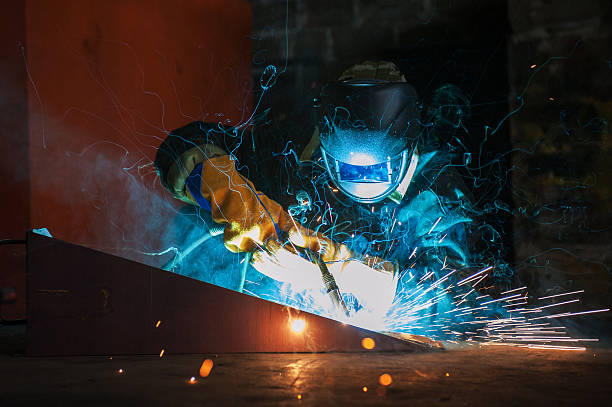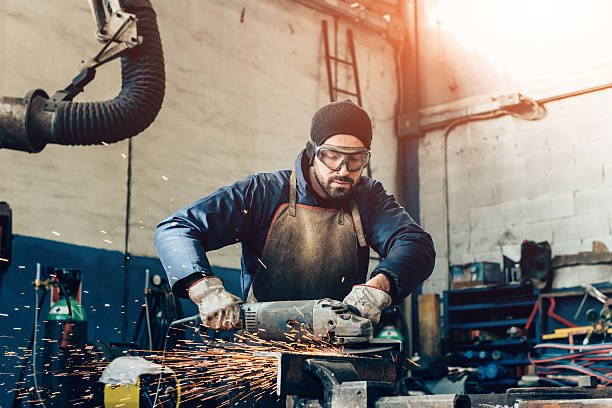Hot work means any activity in which flame, heat, or spark is generated. It may act as a source of ignition (fire) in the area where flammable material is placed or handled. Hot work includes cutting, welding, brazing, soldering, and any process involving the application of a naked flame. Where the flammable atmosphere is potentially present Drilling and grinding activity should be included in Hot work
Hot work is particularly dangerous when it occurs in the presence of any potentially flammable gases/vapors/liquids/solids. Almost 6% of the industrial fire has occurred during Hot work activity. Therefore specific safety precautions are required during hot work activities
Example of fire/Explosion during Hot work
January 2022 in an ABC Company, On a construction site, A welder and helper were killed in a fire explosion incident when they were doing welding on the overhead structure which is about 10ft height. Instead of using a ladder, they used an empty drum which was used for Diesel handling ( for crane, hydra, mixture machine at a construction site) The welder did not notice the traces of diesel inside the drum. One spatter went inside the drum through the open lid and the vapor cloud of the diesel got exploded.
Hazards of Hot work
The most common Hazard of hot work is fire and Explosion
Fire Hazard:
Spark (Spatter): Generation of spatters (Spark) during welding, cutting, grinding or any other activities easily provide ignition sources to the fuel for initiating fire
Molten metals, slag, or swarf: molten metal and slag which is generated from cutting or welding activities have a very high temperature it can easily burn any material within a fraction of time
Heat conduction on the metals: Metals( pipes, channels) got heat up easily during hot work and by conduction heat may get travel from one end to another end. In presence of flammable atmosphere or material on another end, it caught fire
Explosive environment: Vapoure or gases of flammable material in the air can easily ignite during hot work so before starting any hot work removing such gases required
Other Hazards
Health hazard: During welding or cutting activities fumes are generated which is hazardous for the respiratory of the welder. Not only welding fumes but also fumes generated from residue deposits on a cutting/welding surface.
Electrical Hazard: Welding machines, grinding machines and all other equipment used for hot work are power by electricity which has a risk of Electrocution
Radiation: Welding generates UV lights which affect Eyes if seen by naked eyes
Burn Hazard: Molten metals or any hot surface burns the body parts if touched during hot work
Hazards during Hot work is dependent on the specific working area where hot work is carried out

Control measures for Hot work
Elimination: Eliminate hot wok activities to avoid the risk of fire or explosion. Ex. if any machine part got broken in a highly flammable area replace that part with a new one instead of welding.
Substitution: Replace Hot work with less hazardous method Ex. despite welding, use drilling/Tapping and fixed damage part with nut bolting, Or use a cold cutting method instead of hot cutting method
Engineering control: Use engineering controls to remove flammable gases/liquids from hot work areas ex. exhaust fan, blowers, etc.
Administrative controls: Hot work must be carried out by an authorized person, provide training, follow permit to work, work instruction, etc. to reduce risk of hot work
Personal Protective Equipment (PPE): PPE is the last level of defense in the hierarchy of controls. Use appropriate PPE such as face shield, mask, leather hand glove, apron, shoes, etc.

Common Safety precautions for Hot work
- Hot work permit required for any hot work activity
- The surrounding area must be free from flammable and combustible materials
- Hot Work shall not be carried out in or adjacent to any hazardous area unless a Gas Test has been carried out using an authorized Gas Tester
- Atmosphere testing shall be required whenever the hot work is performed within a radius of 15m to
- Storage tanks/ vessels/ containers, pipelines, fuel cylinders etc containing (or had contained) flammable
- Any open-drain points, sample points, pits/sewer systems, etc. where flammables may be present
- Ducts handling flammable (e.g. paint fumes,un-burnt fuel)
- Other (as identified during site visit)
- Gas testing shall be carried out in the interval of 2 hrs if working near above locations or in case of working in the proximity of area where the risk of fire and explosion is more, continuous monitoring of flammable gases required
- All equipment must be free from defects, inspect all equipment before use, make sure the following parts are in good condition to avoid any incidents
- Welding: Machine condition, cable insulation, welding holder insulation, Main Switch (ELCB), Proper Connection and Earthing
- Gas Cutting Set: NRV, Pressure gauges, gas pipe, leak test, gas torch, cylinder condition, trolley, cutting torch condition
- Power Tools: Condition of tools, insulation, power cables, operating switches, etc.
- Never use the cigarette lighter to light the cutting torch
- Use appropriate PPE for hot work such as leather hand gloves, leather apron, welding suits, welding shield, face shield, Hi-vis
- Always keep an emergency plan ready to mitigate emergencies. keep fire extinguishers, hosepipe, sand bucket, water bucket or fire tender ready according to the severity of work for combat against the emergency
- Always check wind directions for working in open areas, everyone must be alerted for fire risk
- Use welding booth for welding
- Appropriate fire blanket required to stop spatters to spread
- Hot work must be carried out by an authorized person(welder, fitter, etc.) who is trained for hot work
- Always avoid hot work on height, do it on the ground. Keep the least job for height.
- Barricade the area to restrict the entry of personnel to avoid falling off a spark.
- Gas cylinder must-have safety cap on it
- Always keep the cylinder in an upright position and secure with a chain
- Smoking should not be allowed in a gas cylinder storage area
- Avoid hot work whenever possible use a hierarchy of controls to avoid such activity
- Hot work must be carried out in presence of a fire watch
- After completion of Hot work, the area must be monitored for at least 30 minutes to eliminate the risk of the late fire
- Use appropriate ventilation for hot work in confined space
For safety videos related to the hot work follow us n linkedin
for more toolbox talk click here…

Very useful and knowledgeable content for industrial safety point of view
Thank you Ishan
Very true. If required processing are followed the rate of hazards will be reduced.
This piece is so instructive.
Thank you.
It’s impressive
Very useful for industial safety
Very useful contest thanks
Very useful. Thanks Buddy
Very Informative.
Considered each & every aspect related to subject.
Thanks
Shriprakash Yadav